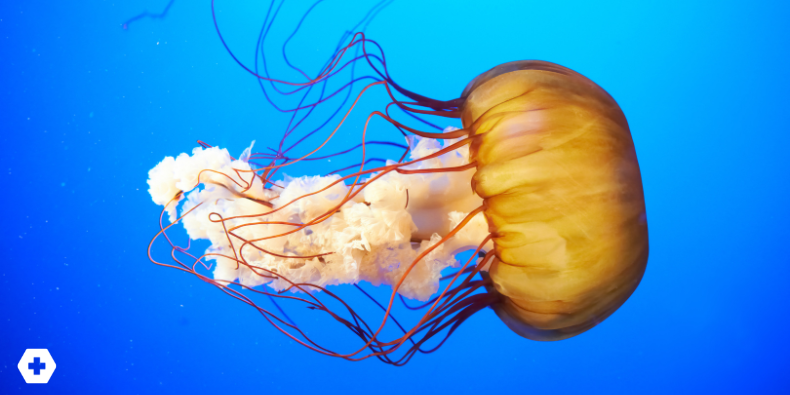
Jellyfish Sting in Urgent Care: A Stepwise Guide for Clinicians

It’s a busy summer shift, and someone walks in, limping, pointing to a red, angry welt twisting around their leg. “I think I got stung by a jellyfish.” It’s a classic beach-day-gone-wrong. So—how do you treat a jellyfish sting? Here’s your evidence-based step-by-step guide for urgent care.
Step 1: The History & Physical—Saltwater Edition
Before diving into treatment, get the scoop:
Where did it happen? Geography matters. A box jellyfish off the coast of Hawaii is a very different beast from the moon jellies off Maine. Knowing the location helps determine the risk of complications, the severity of symptoms, and which steps in management will work best.
How long ago? Those with immediate pain and welt formation suggest active envenomation, while patients presenting with delayed symptoms are more likely to be experiencing a secondary reaction.
What have they already tried? Spoiler alert: urine is still not a treatment. Patients often turn to myths before presenting to the clinic, so clarifying what’s already been done can help guide your next steps.
Any allergies or past stings? Anaphylaxis is rare, but real. Ask about any prior jellyfish stings and reactions.
Any systemic symptoms? Ask about chest pain, trouble breathing, nausea or dizziness. These are red flags that deserve more attention than vinegar and ibuprofen.
On exam, look for:
-
▪️Whip-like, red welts
-
▪️Remaining tentacles—yep, they’re clingy.
▪️Vital signs: always worth checking.
Step 2: What to Do (and Not Do)
DO:
-
▪️Remove tentacles gently with tweezers or gloved hands. No scraping, rubbing, or going at it with a beach towel. This can trigger further envenomation.
-
▪️Soak in hot water (42–45°C / 107.6–113°F) for 20–45 minutes. This helps deactivate the venom.
-
▪️Rinse with vinegar (4–6% acetic acid) for certain jellyfish species stings (reminder: geography matters). No vinegar? Seawater is your next best bet.
DON’T:
-
▪️Don’t use fresh water or urine. Urine is a myth. And fun fact: Jellyfish tentacles contain specialized cells called nematocysts, which can fire off venom when exposed to the osmotic changes caused by freshwater. Instead of helping, a freshwater rinse can make the sting worse.
-
▪️Don’t apply pressure bandages. Applying pressure can actually worsen the spread of venom.
Step 3:Treat the Pain
Stick to your basic first-aid. For minor jellyfish sting treatments, this will be all the patient needs in order to feel relief from their symptoms.
-
▪️Oral analgesics: NSAIDs or acetaminophen usually do the trick.
-
▪️Hydrocortisone cream: Good for inflammation and the inevitable urge to scratch.
-
▪️Antihistamines: Oral or topical for that itchy aftermath.
Step 4: Know When to Worry and When to Wave Them Goodbye
While the majority of stings are localized and self-limited, keep your antennae up for the rare but serious ones. Systemic symptoms like chest pain, trouble breathing, or nausea should prompt a quick escalation in care. Extensive stings, involvement of sensitive areas like the face or genitals, or known contact with high-risk species like box jellyfish or man o' wars warrant extra caution. When in doubt, trust your clinical gut.
Even if the sting looks mild and the patient is stable, your job isn’t quite done. Discharge instructions are key: encourage continued hot water soaks if the pain lingers, watch for signs of infection (like spreading redness or fever), and make sure they know when to come back. Those red flag symptoms? Definitely not ones to ignore at home.
From Sting to Swing Back Into Summer
Managing jellyfish stings is mostly about calming the chaos, neutralizing venom, and treating pain—all with a side of myth-busting. As clinicians, we get to be both the calm in the sting-induced storm and the ones who send our patients back to the waves smarter and safer. So next time a jellyfish sting slithers its way into your urgent care room, take a breath, grab the vinegar, and dive into your stepwise plan.
Just don’t let anyone pee on it.
Practice-Changing Education
Experience education that goes beyond theory. Explore Hippo Education’s offerings below.



